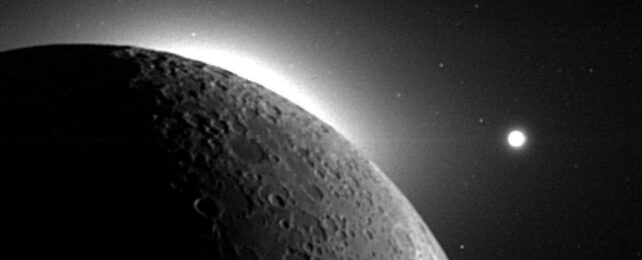There's nothing else like Earth and its Moon in the entire Solar System. Other planets either have multiple moons, or none at all, but the mass ratio of our world and its hefty satellite is quite unique.
The question of our unusual moon's origin, therefore, is one of planetary evolution, figuring out the pathways for various planet-moon configurations. Right now, the leading theory is that the Moon is either Earth's child or its sibling – born of the same material in the same region of the Solar System.
New research is posing a challenge to that notion, suggesting that the Moon could instead be adopted, born elsewhere in the Solar System only to be later embraced by the power of Earth's gravity.
Astronomers Darren Williams and Michael Zugger of Pennsylvania State University have crunched some numbers and found that the gravitational capture of moons is possible for terrestrial planets like Earth, and therefore a possible origin for the observed Earth-Moon system we have today.
We have a lot of evidence that Earth and its Moon are made out of the same basic material. The mineral composition of both bodies is as close to identical as you'd expect it to be if they formed from the same stuff.
The Giant Impact Hypothesis is the prevailing explanation for this similarity: Something large smacked into Earth and the resulting debris coalesced back into a planet and the Moon.
There are other ways that the two bodies could have wound up with the same composition. It may have formed in the cloud of a vaporized planet, known as a synestia, or perhaps it simultaneously formed from the same cloud of dust orbiting the Sun as Earth.
But there's more than one way to acquire a moon, as we've seen elsewhere in the Solar System. If two bodies pass each other at the correct angle and the velocity, they can become gravitationally bound together and end up in a stable, long-term orbit.
The particular scenario that might be relevant to Earth and the Moon is known as binary capture. In this scenario, two bodies that are already gravitationally bound together pass a third body. This third body snares a member of the binary pair, separating them and keeping the binary companion for itself.
We know there are lots of binary objects out there in the Solar System; we keep finding binary and even trinary asteroids, for example. There's even evidence that this three-body gravitational interaction has produced a binary capture, with Neptunian moon Triton. Triton orbits Neptune in the opposite direction from the rest of Neptune's moons, and at a different angle, suggesting it was yoinked out of the Kuiper Belt and into a wonky Neptune orbit.
The Moon, Williams and Zugger say, has an orbit around Earth that isn't as neatly aligned with the equator as you might expect from the debris cloud origin. So, they performed a bunch of mathematical modeling to determine whether something the size of the Moon could be captured by something the size of Earth.
According to their calculations, Earth could have captured something even bigger – a Mercury- or even Mars-sized object – although the orbit would not have been stable. But something the size of the Moon could have ended up in an elliptical orbit that became more circular over time, and eventually began to drift away at the same rate the Moon is receding now, at about 3.8 centimeters (1.5 inches) per year.
So, it's possible. But is it probable? There are still other properties – such as the mineral and isotope similarities – that are more consistent with a closer relationship between the two bodies than the capture scenario would allow for.
But it gives us an avenue for exploration and study that could help us understand not just our own planet, but how such systems can form in orbit around other stars, elsewhere. Since the Moon is thought to have played an important role in life's evolution on Earth, this may help us find habitable worlds elsewhere in the Milky Way galaxy.
"No one knows how the Moon was formed," Williams says. "For the last four decades, we have had one possibility for how it got there. Now, we have two. This opens a treasure trove of new questions and opportunities for further study."
The research has been published in The Planetary Science Journal.
